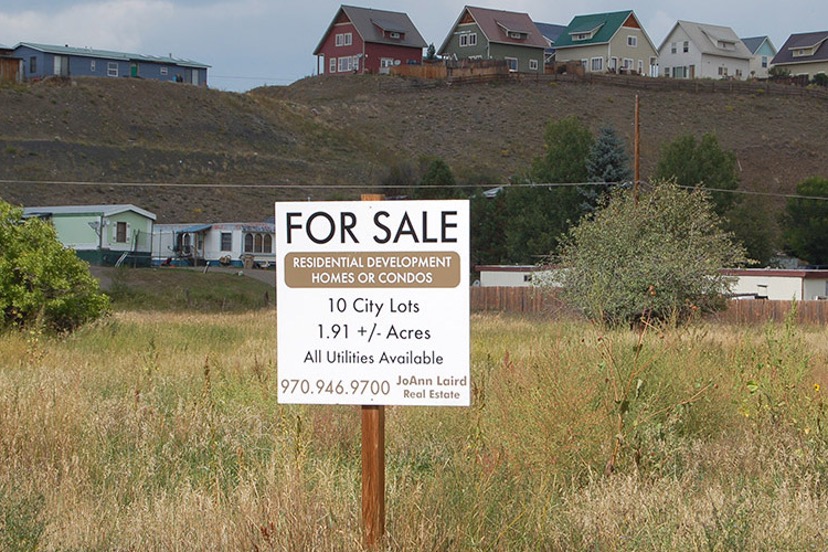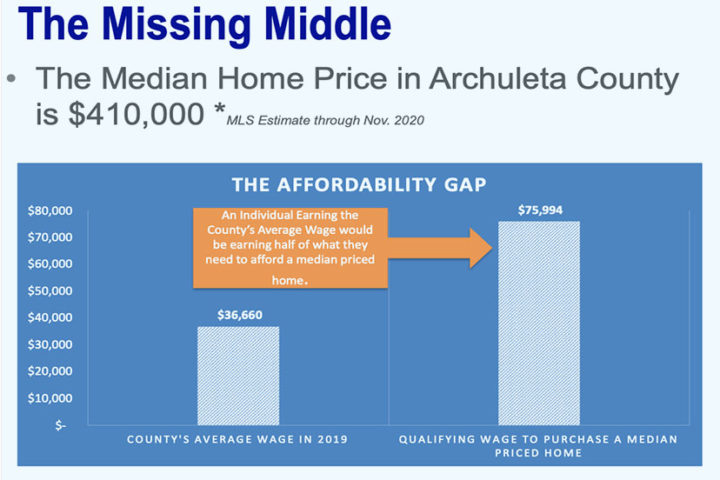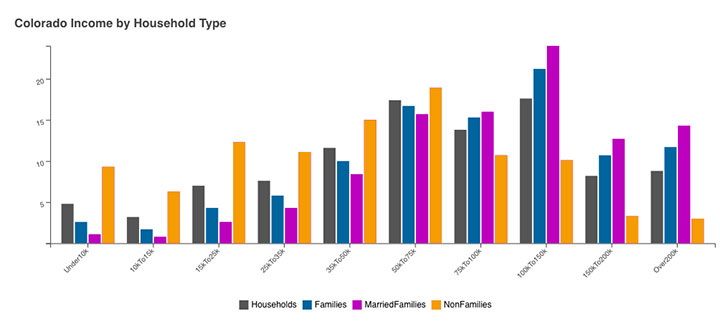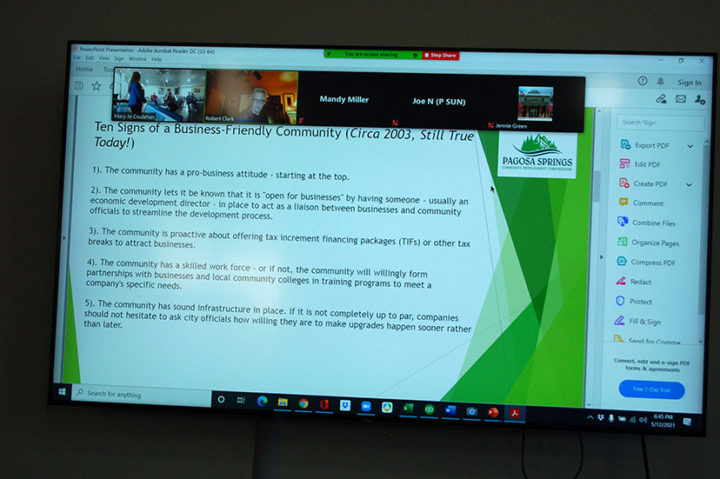I was reasonably familiar with the other presenters at the May 12 annual meeting of the Pagosa Springs Community Development Corporation (PSCDC): Sherry Waner, Chief Development Officer for First Southwest Bank; Chamber of Commerce Executive Director Mary Jo Coulehan; County Commissioner Warren Brown; Town Manager Andrea Phillips; and the two gentlemen responsible for the Archuleta County Broadband Services Management Office, Jason Cox and Eric Hittle.
I have yet to meet PSCDC Executive Director Robert Clark in person… although I was able to hear his Zoom presentation at the Wednesday annual meeting. (He was attending from his home in Texas.)
Mr. Clark is currently the “Recovery Coordinator” for Archuleta County — which is a reference to “economic recovery” from the COVID pandemic, something that we might assume is underway. He also lists his job as “Executive Director” for PSCDC.
As far as Pagosa “recovering” from the COVID pandemic, the “recovery” facing us is rather different from what many other American communities are facing. The Pagosa economy — by some measures — absolutely took off during the pandemic. In terms of making money, we did really well over the past year. The “recovery” — if we can, indeed, recover — will have much more to do with a dysfunctional job market and housing market.
Certainly, the price of real estate, and the cost of long-term rent, both skyrocketed over the past year, as part of an ongoing pattern of increasing costs we’ve watched since 2012.
Yesterday, I shared the graph above in my editorial about the Town’s ‘Urban Renewal Authority’. The graph was created by Durango-based SEH Engineering — a branch office of the national SEH organization headquartered in St. Paul, Minnesota. We’ve heard many discussions by our community leaders over the past four or five years, about the housing crisis, but this is the first time I’ve seen anyone illustrate the problem in this particular format.
According to some measures, Archuleta County is a relatively affluent community, when compared to all 64 counties in Colorado. The most recent data I am able to find (from 2019) indicates that the median household income in Archuleta County was about $52,000 per year, which suggests our community is “above average” among the counties in Colorado — which in turn ranked 10th among US states, in 2019, in terms of household income.
But according to SEH, as we see above, the average annual wage in Archuleta County was about $37,000 — half of what an employee would need to earn to afford a mortgage on a median-priced home here. The full meaning of this number doesn’t always get grasped by our community leaders, however, because it’s commonly assumed that households include two wage earners — with each wage earner contributing a median wage.
Not necessarily the case. Here’s a graph of income levels in Colorado, comparing “families” to “non-families”. As we see, the majority of Colorado households that earn $75,000 or more are classified by the US Census as “families” (the blue bars) while the vast majority of households that bring in less than $75,000 are “non-families” (the orange bars) particularly in the “less than $35,000” categories. Even in the $25K – $35K range, we have twice as many “non-families” as we have “families”.
Half of our community’s employees earn less than $36,000 per year (according to SEH) which puts them, most likely, in the “non-family” category — and suggests that they are completely unable to afford a median-priced home. Or even, in Pagosa, a rental unit.
Region 9 Economic Development District estimated about 6,800 employed individuals — including self-employed individuals — in our county of 14,000, of whom about 11,500 are adults over the age of 18.
Close to half of our adult population, then, is not employed. I assume they are retired. That’s an assumption, at this point.
In Part One of this editorial series, yesterday, I shared a slide from Mr. Clark’s Power Point presentation, in connection with his suggestion that a “business friendly” community exhibits ten essential characteristics. Among those characteristics, he told us, were included the presence of an “economic development director” (such as himself). Also essential was leadership coming from “the top”; sound, consistently maintained infrastructure; competent public safety and administrative services; a good school system; support for recreation and the arts; a dedication to “positive” public relations; a willingness to cut through government red tape; an efficient system of real estate brokers.
During his presentation, Mr. Clark reminded us that he’s been in our community for only 6 months, and does not yet have a handle on the whether our community can provide the necessary items in his a list of “Ten Signs of a Business Friendly Community (Circa 2003, Still True Today!)”
But I need to touch on Number 5 in this list from 2003.
The community has a skilled work force…
Maybe in 2003, the need for a skilled workforce was merely one minor detail in a list of ten signs of a business-friendly community. Yesterday, I visited Indeed.com — a job listing website — and did a search for job openings in the zip code 81147. I found 14 pages of job listings, and each page had about 16 job openings. According to my pocket calculator, that indicates about 225 jobs unfilled on May 13.
We must ask: how many of those unfilled jobs will remain unfilled, because the people with the necessary skills cannot find an affordable place to live within the 81147 zip code?
Curiously enough, Mr. Clark’s 2003 list of “Ten Signs” did not include what is perhaps the most important “Sign” of a viable community: places for working families and individuals to live. Without employee housing, it’s pretty unlikely — in my humble opinion — that any new businesses will choose to locate in Archuleta County, no matter how talented our local economic development directors might be.
If I were composing a list of “Ten Signs for 2021”, Number 1 would be “housing options suitable for everyone interested in holding a job.” The rest of it is merely icing on the cake, by comparison. We have plenty of places for second-home owners to live. We have plenty of places for tourist families to stay. We have local governments that have seen windfall tax collections over the past year. These are not current problems.
But we have a serious problem, if our economic development agencies don’t recognize the importance of work force housing.
Read Part Three…




